|
|
 |
|
Ancient Influences on Renaissance Art |
|
written
by heberj / 09.20.2004 |
|
|
|
Influential Works |
| |
Apollo Belvedere |
| |
| |
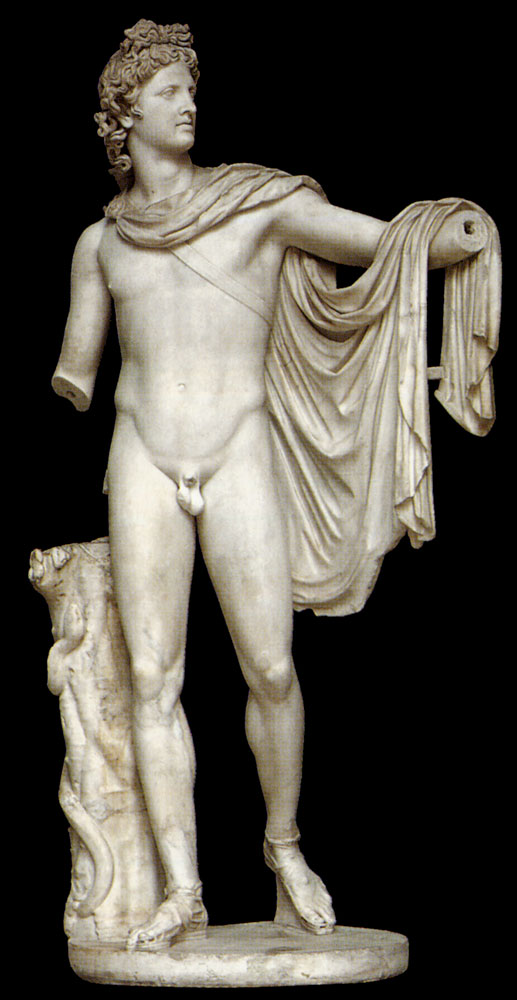
|
|
| Apollo Belvedere |
| The Apollo Belvedere staute. |
| |
|
| |
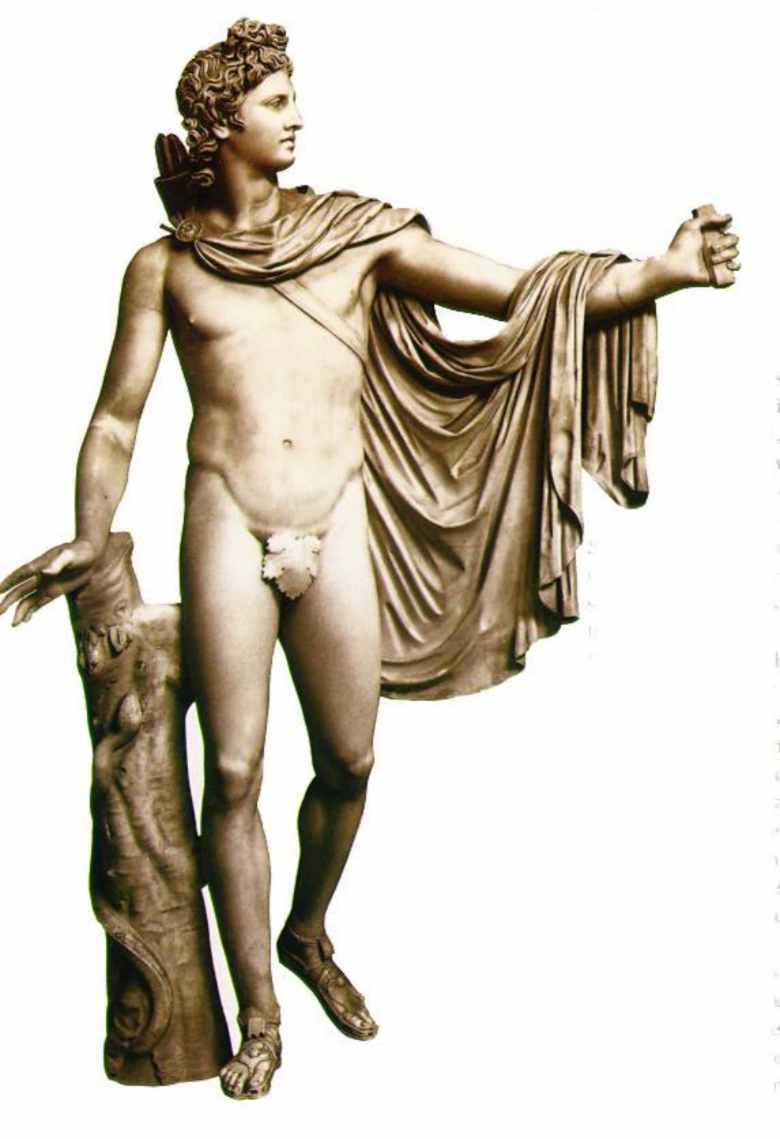
|
|
| Apollo's hands |
| The incorrectly restored Apollo Belvedere with empty hands. |
| |
|
| |

|
|
| Apollo Headshot |
| A close up on Apollo's serene face. |
| |
|
The sculpture of Apollo Belvedere was referred to by J. J. Winckelman as "the consummation of the best that nature, art, and the human mind can produce". This statue is thought to be a second century marble copy of a Greek bronze original. It was found in the late 15th century and acquired by the Vatican in 1511.
This statue is the epitome of classical art and sculpture. This can be seen through the extremely realistic folds and falling of the cloak, as well as the perfection of the male figure depicted who is most likely the god Apollo. His stance is also of note; he is realistically positioned with one leg bent, a position referred to as contraposta. This statue is as well seen as a nearly perfect representation of the human figure. The effects of the classical style are also seen in that Apollo is in a calm serene state; he is not engaged in any violent actions or emotions, but rather is calmly posing. This statue is the epitome of classical style and is everything that the renaissance artists strived to achieve.
The statue as it can be seen in the Vatican Museums is completely un-restored, though at one point it was. Michelangelo was greatly opposed to any restoration of ancient works, but would suggest others to do so in his place when he was asked to do so. It was through such a student, Montorsoli, that Apollo Belvedere was at one point incorrectly restored. This restoration was shown to be wrong by the fact that Montorsoli left Apollo's hands empty, while the quiver of arrows on his back implies that he should be holding a bow. It is now hypothesized that the statue originally included Apollo holding both a bow and a laurel branch, symbolizing the two contrasting sides of Apollo: his punishment of the wicked and his forgivement of the repentant.
|
| |
|
| |
|
| |
Laocoon |
| |
| |
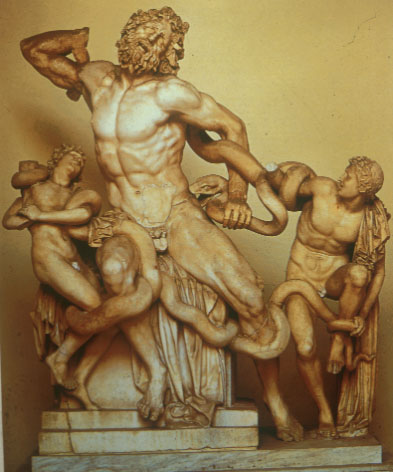
|
|
| Laocoon |
| The Laocoon as it can be seen in the Vatican Museum. |
| |
|
| |

|
|
| Laocoon's Face |
| The extremely emotive face of Laocoon |
| |
|
| |
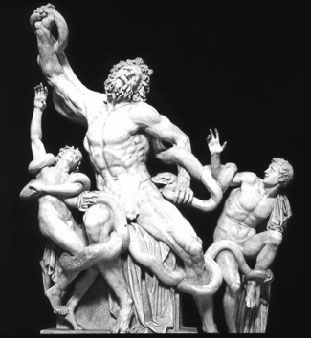
|
|
| Lacoon v1.2 |
| One of the attempts made at restoring the Laocoon that was found to be incorrect. |
| |
|
The Laocoon is once again a Roman copy in marble of a Greek original, dated back to between 42 and 20BC. It is rumored to have been made by three great Greek sculptors: Agesander, Athendoros and Polydorus. This statue was found in 1506 near the site of Nero's Golden House but it is possible that either it was a possession of Nero’s or some other wealthy Roman.
The unearthing of the Laocoon in 1506 made for quite a ceremonious event. Michelangelo was in Rome at the time just after having finished his David in Florence and was able to be present at the unearthing. Immediately the group gathered there recognized the work from Pliny's histories as Pliny had described it among other things as 'superior to any other work in sculpture or painting'. As Pope Julius II was a lover of antiquities he of course immediately acquired the great work; church bells are said to have rung all throughout Rome as it was taken to the Vatican. It was immediately placed in the newly constructed Belvedere Courtyard and has resided in its niche there for all but 13 of the last 500 years.
The figures depicted in Laocoon are the priest Laocoon himself whom the statue is named after along with his two sons. Laocoon was a priest of either Poseidon or Apollo, and lived in the city of Troy. He is known for having attempted to warn his fellow Trojans against accepting the horse from the Greeks with the words 'Do not trust the Horse, Trojans, Whatever it is, I fear the Greeks even when they bring gifts.' His advice was not heeded of course and in his anger he hurled a spear against the horse, some say even hence producing a noise when weapons inside rattled. However, this act had sealed his fate for both Poseidon and Athena favored the Greeks in this war and they sent two sea serpents to kill Laocoon and his two sons, the scene depicted in the statue. The Trojans however misinterpreted his death as a sign of anger from the gods for hurling the spear at the Horse and immediately accepted the gift, meeting their own end as well. This statue serves as a symbol for the fall of Troy in that through the story of Aenas. Aenas escaped the fall of Troy while carrying his father on his back, displaying his virtues and later going on to found Rome. Hence this statue serves as a symbolic reminder of the fall of Try and the birth of Rome.
This statue had a profound influence upon Michelangelo. Michelangelo was present from the unearthing of the statue on and as an artist in such great favor with the Pope he enjoyed the special benefit of being able to spend far more time studying it than anyone else. He was most influenced by the figures depicted in their violent conflict with the serpents. This statue is rather Hellenistic in that the scene portrayed is one of action and emotion and it does not strive for the perfection, harmony and symmetry of the classical work. Instead it shows three people desperately struggling for their lives. The expressions of pain on the faces are also of note; they have a profound effect upon the viewer as a view from the backside highlights, a completely different mood is created. Michelangelo had always wanted to depict muscular movement in some way other than showing off strength and this was a blueprint depicting exactly how to do so. Michelangelo is now viewed as being on the forefront of the movement to Baroque and it is very possible that this statue through its emphasis on climax and emotion came to influence him into that direction.
When the statue was found it was in remarkable shape missing only Lacoon's right arm. As many people in the Renaissance focused on perfection, there was a general desire to correct the statue's flaw by replacing the missing arm. Michelangelo took an entirely opposite view in general upon restoration and refused to help restore any statue, often suggesting others to work in his place. Pope Clement went on to hold a contest for the best replacement arm and had Raphael judge the entries. The winner had Laocoon's arm held out, up into the air forming a diagonal with his left leg. This pose is thought to be more heroic and almost gives the impression that Laocoon has a chance at fighting off the mighty serpents. However this restoration was incorrect and several other attempts were made before the original arm was excavated in 1957. This find proved that the original arm had been strongly bent at the elbow, which one should note is exactly the position suggested by Michelangelo as most likely. The found arm was put back onto the statue, though due to the many attempts to restore it one can see additional cuts had been made to the shoulder of the statue, further degrading the precious ancient work.
As previously stated the Laocoon statue has resided almost entirely in its niche in the Belvedere Courtyard since its excavation in 1506. The only period at which it was not there was after Napoleon conquered Rome and removed it for placement in his palace, the Louvre. Napoleon did not last very long as an emperor however and it was returned in 1813 to the Vatican by the British. At one point the French King Francis I asked of Pope Leo X for the Laocoon statue, or at least one equally as grand as it. The Pope obviously did not want to part with such an incredible statue asked Bandinelli if he could make a copy on par with the original. Bandinelli replied that he could do even better and while that may or may not be true, the Pope liked Bandinelli's copy enough that he kept it as well and sent to the French King only the plaster casts used in making the copy.
|
| |
|
| |
|
| |
Belvedere Torso |
| |
| |

|
|
| Belvedere Torso |
| The Belvedere Torso |
| |
|
| |
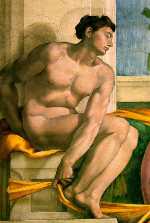
|
|
| A familiar torso. |
| This torso looks quite similar to the Belvedere Torso |
| |
|
| |
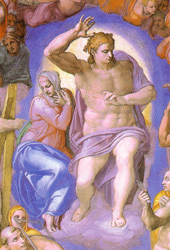
|
|
| Christ in the Sistine |
| This pose of Christ resembles the Torso even more closely. |
| |
|
The Belvedere Torso was another statue found unceremoniously in the 15th century and brought to the Vatican by Pope Clement in 1523. This statue is again a Roman copy of a Greek original, and is dated via the inscription on the base to the 1st century BC. This is possibly a statue of Hercules or Apollo, though current thought is now leading to the possibility that this is a statue of Ajax pondering the death of Achilles. Though as one can obviously see there is an extremely limited context from which one can make judgments as the statue is lacking arms, legs and a head. This statue is obviously un-restored, and that is probably for the better as the lack of context would make restoration efforts rather improvisational. Michelangelo admired this statue and the pose portrayed immensely. His admiration for it came from the sense of internal struggle that is portrayed so elegantly and done so only with a torso. He often referred to it as his teacher, and went on to use copies of this pose throughout his future work and notably in the Sistine chapel.
|
| |
|
| |
|
|
 |
|








